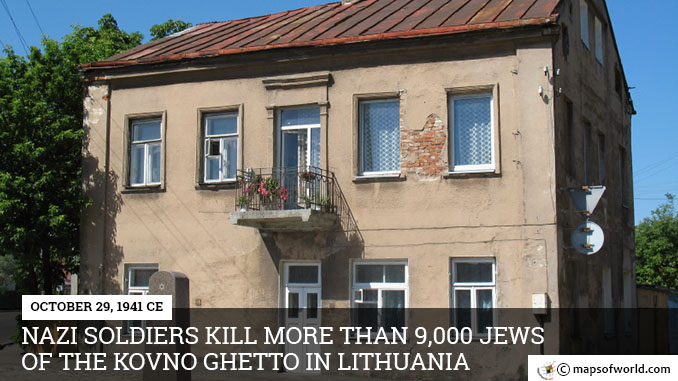Just months after establishing martial law in the captured territory of Lithuania, soldiers from Nazi Germany set out exterminating the Jewish population near Kaunas. After moving 9,000 of the city’s Jews out of the Kovno Ghetto to the Ninth Fort, the Germans mowed them down in a hail of gunfire on October 29, 1941. The “Fort of Death” had earned its legacy. Though the Germans had conquered Poland in 1939, leader Adolf Hitler held off on turning his army to the northeast toward Lithuania for nearly two years. When the invasion finally occurred on June 22, 1941, the Nazis made quick work of rolling back the Soviet opposition. Welcomed as liberators following victory in the Battle of Raseiniai — occupation by Stalin’s forces had been considered oppressive — the Germans established a provisional government, keeping it in place just long enough to authorize the creation of Jewish ghettos. During the six weeks the Lithuanians had nominal self-rule, the Nazis began cordoning off the Jews in specific neighborhoods in every city, such as the Kovno district of Kaunas. By August 15th, ten days after the Germans instituted military control in the areas it occupied, the ghetto contained nearly 30,000 people — each with less than 10 square feet of personal space. Divided into a “small” and “large” sections, security along the constantly-shrinking barbed wire borders of the ghetto was incredibly tight. On October 4th, Nazi leadership announced a change: the smaller portion of the ghetto would be closed. Residents were herded off to the Ninth Fort, part of the massive Kaunas Fortress near the city center, and quietly executed. The complex had been a labor camp during Soviet rule, and the Nazis would make it one again, but not before another killing spree. Rallying Lithuanians to the cause, SS leaders Karl Jager and Helmut Rauca announced a “Great Action” would be necessary. Inhabitants of the Kovno ghetto were called into the center of the cramped neighborhood, where Rauca informed approximately a third of them he and the Kaunas Gestapo (secret police) would be escorting them to another location the following morning, October 29, 1941. Loading at least 9,000 Jews into trucks — including more than 4,200 children — the Germans headed to the Ninth Fort, lining the prisoners up alongside massive pre-dug graves. With ruthless efficiency, machine guns cut through the helpless Jews. By late afternoon, all were dead. With the bodies hidden under mounds of earth after the massacre, the Ninth Fort transitioned into a full-time extermination center. Pulling Jews from across Austria, France and Germany, the Nazis went on killing prisoners at the “Fort of Death” until the Soviets reclaimed Lithuania in 1944. After World War II ended, the Ninth Fort resumed its place as a jail for Soviet political prisoners in 1948. Closed after a decade, it turned into a museum. During an extensive forensic search of the former prison in 1960, the discovery of the mass graves on its grounds led to a detailed analysis of the Nazi crimes. In 1984, a monument to the victims was erected on the grounds with a separate plaque near the grassy field where the crimes were committed. “This is the place,” it reads, “where the Nazis and their assistants killed more than 30,000 Jews from Lithuania and other European countries.” Also On This Day: 539 BCE – Cyrus the Great conquers Babylon and ends the Jewish Captivity 1618 – Sir Walter Raleigh is beheaded for a suspected plot against King James I of England 1863 – The International Red Cross is formed at a meeting of 18 nations in Geneva 1929 – The Crash of ‘29 officially signals the start of the Great Depression 1969 – Computers connect for the first time with ARPANET, precursor to the Internet
October 29 1941 CE – Nazi Soldiers Kill More Than 9,000 Jews of the Kovno Ghetto in Lithuania

